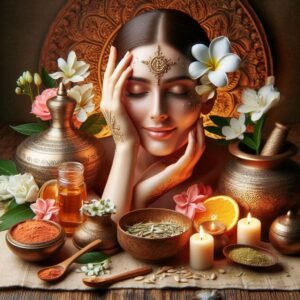Table of Contents
ToggleRejuvenate Your Knee Joints with the Ancient Healing Science of Ayurveda
Joint pains have become widespread in today’s sedentary lifestyle, affecting people across all age groups. One of the most effective and time-tested Ayurvedic therapies to combat knee pain is Janu Vasti, also known as Janu Basti. This treatment focuses specifically on the knee joints, relieving chronic pain, stiffness, and degeneration. Ayurveda emphasizes treating the root cause rather than just symptoms. Let’s understand the major reasons behind knee pain from both modern and Ayurvedic perspectives
🔎 What Causes Knee Pain?
Understanding the root cause of knee pain helps in selecting the right treatment approach. In Ayurveda, most joint issues are linked to Vata imbalance and Ama (toxins) accumulation.
🔸 Common Causes of Knee Pain:
-
Osteoarthritis – wear and tear of cartilage due to aging
-
Rheumatoid arthritis – autoimmune joint inflammation
-
Meniscus tear or ligament injuries – due to sports or trauma
-
Overuse or repetitive strain
-
Postural imbalances – sitting or standing for long hours
-
Obesity – excess weight puts pressure on joints
-
Lack of lubrication – reduced synovial fluid in the joint space
-
Bone degeneration or osteoporosis
-
Metabolic conditions, such as gout or high uric acid
-
Post-surgical or post-fracture stiffness
🪔 What is Janu Vasti / Janu Basti?
-
Janu = Knee
-
Vasti/Basti = To retain or hold
Janu Vasti (or Janu Basti) is a localized Ayurvedic therapy that involves retaining warm medicated oil or ghee over the knee joint for a specific period using a dough ring. This allows the herbal oils to deeply penetrate the joint tissues, relieving pain, stiffness, and inflammation.
It is particularly beneficial for:
-
Osteoarthritis
-
Rheumatoid arthritis
-
Ligament injuries
-
Knee joint degeneration
-
Sports injuries affecting the knee
🔍 Why is Janu Basti Gaining Popularity?
In an age where joint surgeries are common but not always necessary, Janu Vasti offers a natural, non-invasive, and rejuvenating approach. It works by:
-
Pacifying aggravated Vata dosha
-
Improving synovial fluid (joint lubrication)
-
Enhancing blood circulation and nourishment
-
Strengthening ligaments and cartilage
🛠️ How is Janu Vasti Treatment Done?
✅ Materials Required:
-
Medicated oil (Taila)
-
Black gram flour
-
Hot water
-
Cotton, towels, and vessels
🔶 Step-by-Step Procedure:
1. Purva Karma (Pre-procedure):
-
The patient lies comfortably on the Droni (massage table).
-
A dough made of black gram flour is shaped into a well-like ring and placed around the knee joint.
-
The knee area is gently massaged with warm oil.
2. Pradhana Karma (Main Procedure):
-
Lukewarm medicated oil or ghee is slowly poured into the well and retained for 30–45 minutes.
-
The temperature is carefully maintained.
-
The warmth allows deep tissue penetration.
3. Paschat Karma (Post-procedure):
-
Oil is removed, and the area is cleaned.
-
The patient rests for 20–30 minutes.
-
A mild massage or Nadisweda (herbal steam) may follow.
🌿 Ayurvedic Perspective on Knee Pain (Janusandhigata Vata)
According to Ayurveda, knee pain often results from:
-
Vata imbalance – causing dryness, stiffness, and cracking
-
Ama accumulation – toxins clogging joints, causing swelling and inflammation
This leads to Sandhigata Vata, which closely resembles osteoarthritis:
“Shoola (pain), Shotha (swelling), Sparsha Asahatva (tenderness), and Vedana during movement” are key features.
Janu Basti, as part of Vata Vyadhi Chikitsa, helps pacify Vata, clear Ama, and restore normal joint function through:
-
Snehana (Oleation)
-
Swedana (Sudation)
🌟 Benefits of Janu Vasti (Janu Basti)
| Benefit | Description |
|---|---|
| 🔹 Reduces Pain | Warm oil alleviates pain from arthritis, injuries, or overuse |
| 🔹 Improves Flexibility | Reduces stiffness and increases range of motion |
| 🔹 Strengthens Joint | Nourishes cartilage and supports tissue regeneration |
| 🔹 Enhances Circulation | Boosts blood and lymphatic flow to the knee area |
| 🔹 Relieves Swelling | Anti-inflammatory properties reduce puffiness and inflammation |
| 🔹 Prevents Degeneration | Protects against wear and tear in aging joints |
🎯 Indications for Janu Basti
-
Osteoarthritis of the knee
-
Chronic knee pain and stiffness
-
Ligament or meniscus injuries
-
Knee degeneration
-
Osteoporosis
-
Bursitis and tendonitis (non-acute)
-
Post-operative joint care (after inflammation subsides)
🚫 Contraindications
-
Acute inflammation
-
Infected wounds near the knee
-
Skin allergies or burns
-
Recent fractures in the knee region
🧘♂️ Lifestyle Tips to Enhance Janu Vasti Results
-
Avoid cold, dry, and heavy-to-digest foods
-
Practice gentle yoga or physiotherapy as advised
-
Maintain a healthy weight to reduce knee stress
-
Follow a Vata-pacifying diet (warm, oily, cooked foods)
-
Avoid prolonged standing or squatting
❓ FAQs about Janu Vasti / Janu Basti
1️⃣ Is Janu Vasti painful?
No. It is a warm, soothing therapy designed to relieve pain—not cause it. Most patients feel immediate relaxation.
2️⃣ How many Janu Vasti sessions do I need?
Generally, 5 to 7 sessions are recommended. Chronic cases may require up to 10 sessions.
3️⃣ . What is the duration of each session?
Each session takes around 45 minutes to 1 hour.
4️⃣ . Can I get immediate relief from knee pain?
Some patients experience noticeable relief after the first session, but complete results usually come with multiple sessions.
5️⃣ What oils are used in Janu Basti?
Commonly used oils include:
-
Mahanarayana Taila
-
Dhanwantharam Taila
-
Balashwagandhadi Taila
The choice depends on your condition and Dosha.
6️⃣ Can Janu Vasti be done at home?
Not recommended. It requires proper temperature control, positioning, and oil selection—best handled by an experienced Ayurvedic therapist.
7️⃣ Is it safe for elderly people?
Yes. It is highly beneficial for elderly individuals suffering from age-related knee degeneration or osteoarthritis.
8️⃣ Can I combine Janu Basti with physiotherapy?
Yes. Janu Basti can be combined with modern physiotherapy to enhance outcomes, but always under guidance.
9️⃣ Does Janu Vasti have side effects?
When performed correctly, there are no major side effects. However, incorrect temperature or technique may lead to minor burns or discomfort.
🔟 How much does Janu Vasti cost?
The cost may vary depending on the number of sessions and the clinic. At Adyant Ayurveda, At Adyant Ayurveda we charge from Rs. 1400 to 2200 per session.we offer affordable and customized therapy plans. Call 📞 9972541009 for package details.
📍 Best Place for Janu Vasti in Bangalore
At Adyant Ayurveda, we provide authentic Janu Vasti (Janu Basti) treatment under the guidance of experienced Ayurvedic doctors. Our centers in Jayanagar, Indiranagar, Kalyan Nagar, and Rajarajeshwari Nagar are fully equipped to offer holistic joint care.
💬 Call now to book your consultation: 📞 9972541009
✨ Final Thoughts
Don’t let knee pain slow you down. Whether you’re struggling with osteoarthritis, injury, or chronic stiffness, Janu Vasti / Janu Basti offers a safe, natural, and time-tested Ayurvedic solution.
Rediscover pain-free movement and knee strength—with the power of Ayurveda at Adyant Ayurveda.
Referances
-
Comparative Clinical Study of Janu Basti
This study evaluates the efficacy of Janu Basti in managing knee osteoarthritis.
Read the study -
Clinical Study on Janu Basti and Janu Pichu with Murivenna
Research assessing the effectiveness of Janu Basti combined with Murivenna oil in treating Janu Sandhigata Vata (knee osteoarthritis).
View the research -
Osteoarthritis of the Knee through Janu Basti Procedure
A study detailing the application of Janu Basti in patients with knee osteoarthritis, highlighting improvements in pain and mobility.
Access the study -
Evaluation of the Efficacy of Marma Therapy with Janu Basti
This research explores the combined effect of Marma therapy and Janu Basti in managing osteoarthritis of the knee.
Read more -
Controlled Clinical Study on Janu Basti and Asthi Shrinkhala
A recent study compared the effects of Janu Basti combined with Asthi Shrinkhala versus Glucosamine sulfate in managing knee osteoarthritis.
View the study
❓FAQs
1️⃣ Is Janu Vasti painful?
No. It is a soothing and deeply relaxing therapy.
2️⃣ . How many sessions are needed?
Typically, 7 to 15 sessions. Chronic issues may need 10.
3️⃣ . What is the duration of each session?
Approximately 45 minutes to 1 hour.
4️⃣ Will I feel better after one session?
Relief may start from the first session, but full benefits appear over time.
5️⃣ Which oils are used?
-
Mahanarayana Taila
-
Dhanwantharam Taila
-
Balashwagandhadi Taila
(Selected based on your condition and Dosha)
6️⃣ Can it be done at home?
Not advised. It needs expert handling for oil temperature, positioning, and selection.
7️⃣ Is it safe for elderly patients?
Yes. It’s especially beneficial for age-related joint issues.
8️⃣ Can it be combined with physiotherapy?
Yes, under expert guidance for better results.
9️⃣ Any side effects?
When done correctly, none. But incorrect temperature may cause burns.
🔟 What is the cost?
At Adyant Ayurveda, sessions cost Rs. 1500 to Rs. 2200, depending on the oil and protocol.
📞 Call 9972541009 to inquire about packages.





